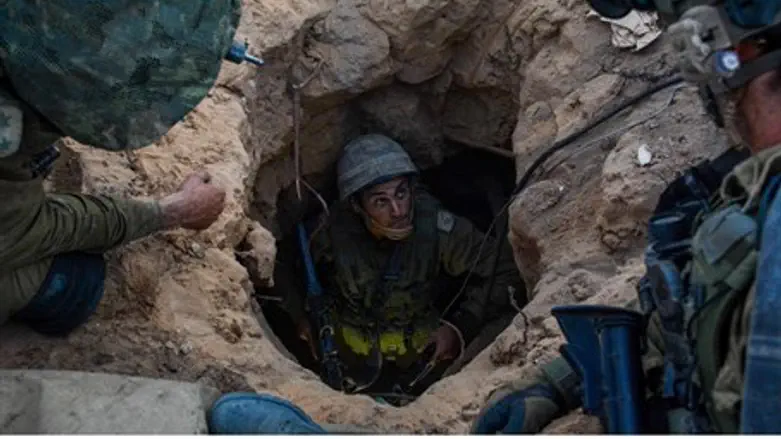
A senior IDF commander responsible for the Gaza region has revealed that the IDF was caught off guard by the number of Hamas terror tunnels leading into Israel - and warns that there likely are more tunnels remaining, ready for use in attacks.
An engineering unit captain in the Gaza Division identified only as Lt. Col. Max held an interview with the Hebrew-language Walla! news site, in which he detailed his experiences locating and destroying the tunnels during Operation Protective Edge.
Speaking about the tunnel threat and whether the IDF was caught off guard, Max said "in the two years that I was close to the matter there wasn't a single person, up to the most senior political echelon, who did not have the issue presented to him in the most detailed manner."
"I think the only surprise that you can really count is how many of the tunnels that we found crossed the border," the colonel admitted in the interview, which was published on Thursday. "Most of the surprise was not the method in which the tunnels were built (such as size and complexity - ed.), but rather how many of them went over the border."
When asked whether any so-called "terror tunnels" from Gaza into Israel remained, Max claimed: "I think that it's correct to assume there are. If we don't do that we'll find ourselves in some kind of illusion that will freeze our development in different advancements. There's also the possibility that some of them (the tunnels) are ready for an attack. I think we must not rule that out."
The assessment comes after Hamas bragged recently that the IDF didn't destroy all of its tunnels during Operation Protective Edge. The terror group, along with Islamic Jihad, have already been revealed to have restarted construction on the terror tunnels since the August ceasefire that ended the operation.
Regardless of that, and the fact that humanitarian materials were siphoned by Hamas to build the tunnels in the first place, Israel began transporting more construction materials into Gaza on Tuesday as a "humanitarian gesture," including 600 tons of cement, 50 truckloads of aggregate and 10 truckloads of steel.
More than 30 terror tunnels into Israel were located and destroyed by the IDF during Operation Protective Edge.
Political echelon decided not to deal with the tunnels
Even prior to the summer war with Gazan terrorists, Lt. Col. Max was well-acquainted with the tunnel threat: last October he was one of five soldiers wounded as Hamas terrorists detonated an explosive in a tunnel leading to an Israeli kibbutz soldiers were working to destroy.
In fact, Max was commander of the operation to destroy the tunnel; the blast burned his face and left him in critical condition, unable to open his eyes.
"The moment of the explosion was a feeling of a big miss from my point of view," he recalled. "I felt like they scored a goal against us. We prepared for it, we constructed drills that were supposed to provide an answer to it, and they still succeeded in hitting us."
In fact, Max's acquaintance with the tunnels goes back further still, to 2007, when there was not much IDF intelligence on them or awareness of the threat among the general public. At the time he was the commander of the Samur company of Sayeret Yahalom, a special ops engineering unit.
Despite the knowledge by military heads of the tunnels' existence way back in 2007, the political echelon decided to ignore the issue and not deal with the tunnels both in 2008 Operation Cast Lead and 2012 Operation Pillar of Defense, he said.
In the interim, and prior to the most recent operation, not only did the tunnel incident in which Max was wounded occur, but another "advanced" tunnel was located this March.
"When you see the concrete reinforced structure and take in the ability to bring in large forces through it (the tunnel), you understand that we 'grew up' from smuggling tunnels to attack tunnels of a scale that can bring about a mega terror attack," said Lt. Col. Max.
While Prime Minister Binyamin Netanyahu controversially agreed to a ceasefire with Hamas (which the latter rejected) on July 15, early on in the operation and before the tunnels were revealed or destroyed, Max claims the IDF was intent on destroying the tunnels during the recent mission.
"After (2012's) Operation Pillar of Defense there was a clear decision that the next operation should include the tunnels," said Max. "The scope wasn't talked about, but there was an understanding that anywhere the IDF conducts maneuvers, emphasis will be placed on dealing with the attack tunnels."
"We developed around that (goal) techniques and drills, and in Protective Edge, when the decision was made to deal with the tunnels, we stuck to everything to make it pay off," said the commander.
Shortly after the operation, Max was named as head of the engineering branch of the center for ground drills in Tze'elim. He revealed there are several projects currently in development to deal with the tunnel threat, many of which were temporarily postponed during the operation but are not moving ahead.
Speaking about the danger moving forward, Max said: "my professional estimation is that the quantity (of tunnels) dealt with and the wide damage dealt will postpone any terror tunnels being carried out for a period, but if we don't take dramatic steps, like creating a physical blockade supported by relevant technologies, we won't return the quiet to the Gaza region."